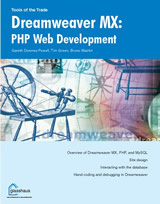 This article will explain more the Dreamweaver MX development environment, and give you a general overview of the possibilities.
This article will explain more the Dreamweaver MX development environment, and give you a general overview of the possibilities.
It is extracted from the book Dreamweaver MX: PHP Web Development
 This article will explain more the Dreamweaver MX development environment, and give you a general overview of the possibilities.
This article will explain more the Dreamweaver MX development environment, and give you a general overview of the possibilities.
It is extracted from the book Dreamweaver MX: PHP Web Development
In the first two chapters of this book, we have guided you through installing and configuring the development tools that you need to begin working successfully with Dreamweaver MX.
Now that you have a web server running PHP, and a MySQL database server configured and ready to use, it's time to get your teeth into what this book is really about: Designing PHP web pages in Dreamweaver MX.
We'll begin by giving Dreamweaver all the information it needs to work with your development environment, by creating a Site Definition. Once your site is defined, we'll take our first look at the juicier subject of Databases, and show you how to create a database connection within Dreamweaver, which will allow you to access the MySQL database we created in Chapter 2.
Summarizing this chapter, we will discuss some of the more common problems and errors that you might encounter, and provide you with simple, no-nonsense solutions, guaranteed to keep the development blues at bay.
Before you begin working through this chapter, you must ensure that you have the following:
· A web server configured to work with PHP (see Chapter 1).
· The Web Server Address, FTP Server Information (if applicable) and Authentication Information (Username & Password).
· A working MySQL Server (see Chapter 2).
· The MySQL Server IP Address and Authentication Information. (Username & Password)
All of this information will be required at some point over the coming pages, and is essential to providing you with the richest development experience possible.
Dreamweaver is a unique tool in the way that it allows you to view your web page within the User Interface. Certainly, there are many WYSIWYG (What You See Is What You Get) web page editors on the market today, but few, if any, offer the rich design experience that Dreamweaver presents. Indeed, Macromedia describes Dreamweaver as a "visual editor" in order to highlight this fact, and many Dreamweaver developers prefer this description.
One of Dreamweaver's best features is its ability to interact with your web server and application server, so that dynamic elements of your web page come to life within the UI, even before the page has been uploaded to your server.
With the above information to hand, we shall now take a look at the essential first steps you should take when creating any web site with Dreamweaver MX.
 Bruno Mairlot works as full time employee in Security and High Availability company based in Luxembourg. He specialises in developing implementation of network and internet protocols with PHP and MySQL.
Bruno Mairlot works as full time employee in Security and High Availability company based in Luxembourg. He specialises in developing implementation of network and internet protocols with PHP and MySQL.
He began his working life as founder of a company for website development and network services four years ago, then moved on to work with other companies, but always working mainly as a website developer and security consultant for the web.
Comments
Be the first to write a comment
You must me logged in to write a comment.